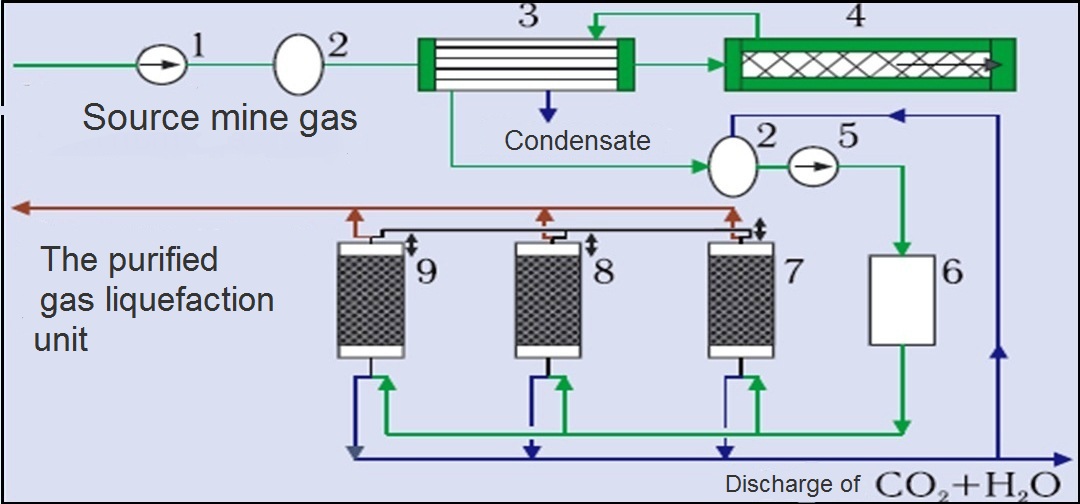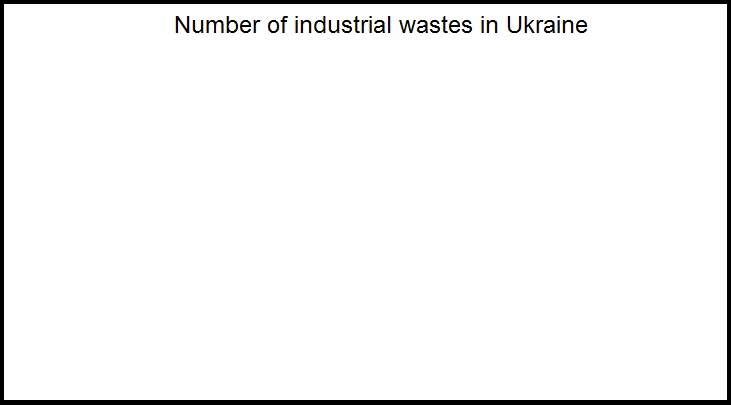Abstract
Content
- Introduction
- 1. The problems of coal mine methane
- 2. Installation of waste coal mine gas
- 3. The
use of industrial waste as
a granular material
Сonclusion - References
Introduction
In addition to industrial emissions and motor vehicles in the mining regions of Ukraine in the first place in Donbass, a significant proportion of methane emissions from ventilation and degasification systems, coal mines. Emissions of methane are invisible andodorless, so little known about their presence, and the public was not enough attention is paid.
1. The problem of waste coal mine methane
The share of coal mine methane emissions in the Donbass region is significant.According to reports, an example of mine "Sukhodolskaya East," which refers to the gassy mines of Donbass methane emissions in 2009 totaled 26.28 million m3. And there are mines in the Donbass region about a hundred. Currently, the development of gas-bearing coal seam degasification systems, and ventilation shafts Russia extracted from 1.2 to 1.4 billion m3 of methane, but only about 25% of the extracted drainage systems, of which only about 45-50 million m3 is utilized, the rest is released into the atmosphere, contaminating its sustainable greenhouse gas. About the same state of coal mine methane is also in the Ukraine [1].
The Kyoto Protocol, adopted in addition to the UN Framework Convention on climate change, commits to reduce or stabilize greenhouse gas emissions. Greenhouse gas - gas block infrared radiation from the earth's surface, which leads to global warming on the planet. Go to the main greenhouse gases are: carbon dioxide (СО2), methane (СН4), nitrous oxide (N2O) and others. Methane – the second most important greenhouse gas, regulated by the Kyoto Protocol. CMM is a strong pollutant of the environment, one of the destroyers of the ozone layer of the atmosphere of the planet and at the same time contains impurities that impair their quality as fuel. In this connection it is necessary to generate assemblies and materials that help provide the necessary quality of this valuable source of energy for future use. To solve this problem, we propose to use the facility for disposal of mine gas and sorbent in the form of granular materials based on the processing of various wastes [2].
2. Installtion of waste caol mine gas
Consider the installation of CMM training, equipment and technology used to clean the gas from contamination with granular material (adsorbent).
As a part of mine gas, in addition to methane, typically are in different proportions of carbon dioxide, nitrogen, oxygen, water and minor amounts of other impurities.
There are mine coal seam gas, which is not the development of coal, gas, abandoned mines and gas operating coal mines. Coal mine gas of coal seams in which coal mining is not conducted, and produced degassing of coal seams, high quality, with up to 90% or more of methane and the minimum amount of impurities. The technology of its processing is quite simple. As a rule, separation and filtration of the solids. Gas closed mines contains 50–70% methane and is not explosive, making it easy to recycle to the concentration of methane [3].
In contrast, the working of mines gas contains from 25 to 40% methane and a significant amount of oxygen that, in view of possible variations and subsequent oxygen enrichment, along with methane, the pairing with the possibility of the occurrence of explosive conditions during processing. The presence of this gas of nitrogen in an amount of 40–60% further complicates the task of processing, causing a significant increase in specific energy consumption per unit of sales gas. In this sense, the technology for the processing of this gas are the most difficult. Let us consider in more detail on the processing technology of mine gas operating mines.
Schematic illustration of the working mines of coal mine gas is shown in figure number 1.

Figure 1 – Schematic diagram of block oxygen removal, removal of СО2 and dehydration:
1 – liquid-ring vacuum compressor 2.6 – Receiver 3 – recuperative heat exchanger, 4 – catalytic reactor, 5 – booster compressor; 7-9 – adsorbers.
Coal mine gas enters the gas collection network for the installation of gas treatment.Before entering the liquid-ring vacuum compressor gas is separated and purified from the coal dust and solids separators in the input. After dozhatiya in a vacuum gas enters the compressor to the receiver, which is required for a given stock of coal mine gas, and smooth the process of preparation. After the receiver is heated in a coal mine gas recuperative heat exchanger that uses heat from the catalytic reactor. After a recuperative heat exchanger in the gas enters the catalytic reactor in which the process of catalytic oxidation of hydrocarbons on the catalyst. The catalyst used manganese dioxide, activated with silver nitrate. The oxidation of hydrocarbons of the methane series takes place in accordance with the reaction:
Heat rejection reaction is removed from the reactor water cooling system, and leaving the reactor at a temperature of 300 ° C, the gas is cooled in a recuperative heat exchanger and sent to the interim receiver and then further squeezed in the compressor up to 0.8 MPa and directed the installation of adsorption and drying gas [7].
Installing the cleaning and drying gas was built under the scheme stirrup canister filled with carbon adsorbent. In each of the adsorbers occurring cyclic adsorption of СО2 and H2O impurities at an operating pressure of desorption (at atmospheric pressure). Gas desorption is discharged into the atmosphere, and the purge gas containing significant amounts of methane, it returns the input of the booster compressor. Switching adsorbers is set valves installed at the inlet and outlet of adsorbers. The product mixture of methane and nitrogen coming out of the adsorbers is sent for further processing for the subsequent cooling of the gas, nitrogen excretion and obtain marketable methane in liquid form. For this purpose, applied nitrogen, cryogenic cycle with pre-cooled and turbo-expander – compressor unit. The separation of methane and nitrogen by cryogenic distillation method [6].
Absorber is a vertical cylindrical apparatus in which the nozzle is used as a desiccant-based activated carbon, which absorbs from mine gas H2O and CO2. The source gas enters the absorber from the bottom, and the purified gas leaves the top of the canister [1].
3. The use of industrial waste as a granular material
Let us consider in more detail on the use of industrial waste as a granular material (sorbent). For many wastes include: waste hydrolysis industry - lignin, emitted in large quantities in the dumps and so-called flushing oil waste that accumulated over decades in the ponds washing and steaming stations in the areas of oil refineries and railway stations. Both types of waste – a valuable hydrocarbon feedstock, efficient and environmentally sensitive use, which promises great economic benefits. Ukraine has also been discovered large reserves of low-grade coal salt, for which found a lot of sound and environmentally acceptable ways to use. One is the production of granular materials used as sorbents.
We know that in the face of rising pollution, the need for activated carbon worldwide is growing steadily, as they are primarily used as a sink. While the annual production of activated carbons in Ukraine is estimated at several tens of tons, the demand for it only in the industrial Donbass region is approximately about 2–5 tonnes / year. In order to reduce the deficit to the development of new sources of raw materials, as well as developing new ways to get active carbon [4].
In this regard, carbon-containing wastes – very promising, natural, affordable and cheap raw materials for the porous hydrocarbon materials (sorbents). In addition to the above-mentioned waste suitable for the production of porous materials is very promising hydrocarbon use of solid waste coal preparation plants and coking plants. Analysis of the literature on this subject suggests that the joint termopererabotka these wastes will increase the efficiency of their utilization, and improve the ecological situation in the country. The use of mixtures of wastes can minimize the disadvantages of a raw material and enhance the dignity of another. The combination of different types of carbon structures, welded together a binder, will synthesize activated carbons with high porosity, sorption centers of different nature and mechanical strength.
Further, the creation of multicomponent systems containing carbon along with the catalytically active metals - is a way of obtaining selective adsorbents act or substrates for efficient catalysts.
At the present time, the resources of lignin in the Ukraine account for more than 5 million tons of coal reserves of low-grade salt – more than 10 billion tons of oil reserves are flush-waste in Ukraine – at least 500 thousand tons, in addition there are quite a large amount of solid waste coal preparation plants, Coke plants, about 25 billion tons, which are the raw materials for activated carbons (Figure 2).

Expansion of raw materials for activated carbons and optimization of processing conditions on the cheap and readily available low-grade coal in Ukraine cheap sorbents, as well as the utilization of lignin and flush accumulated waste oil and solid waste fine coal preparation plants, mines and coking plants - a very relevant and promising task for Ukraine.
Utilization of coal mine methane degasification wells will
provide:
- Reduction of gas concentration mines and as a consequence of this
increased productivity of coal mines and to ensure safe working
conditions;
- Reducing emissions of methane, which refers to greenhouse gases;
- Reducing the need for Ukraine to scarce and expensive natural gas;
- To develop its own electric power and heat generation coal-mining
enterprises.
Disposal and use of methane not only solves environmental problems but
also important for economic reasons, because it allows use of much
cheaper - a gaseous fuel to produce heat (in the boiler) and
electricity [5].
Conclusion
In conclusion, it should be noted that to
reduce emissions of methane, it is
necessary to actively
implement the installation of its
utilization to
generate electricity, heat, andcompressed natural
gas to
fuel cars. The introduction of
such systems will
improve theecological situation in the Donbass.
In writing this essay master's work is not
yet complete. Final completion: December
2012. The
full text of the work and materials on the
topic can be obtained from the author or
his head after that date.
References
- Шендрик Т.Г., Пащенко Л.В., Симонова В.В., Дроздов В.А. Донбас-2020: охорона довкілля та екологічна безпека: Науково-практична конференція / Т.Г. Шендрик и др. – м. Донецьк – 21-22 листопада 2001 р.
- Шахтный метан в России // IEA – Международное энергетическое агентство. – Январь 2010. – 73 с.
- Кузьменко И.Ф., Рубцов А.И., Довбиш А.Л. Технология комплексной переработки шахтного газа с получением товарного сжиженного метана // Технические газы. – 2010. – №3. – c. 36-37.
- Zahradnik R. Conversion оf Соаl Міnе Methane tо LNG for Heavy Vehicle Fuel / R. Zahradnik // Western States Coal Mine Methane Workshop. – Арrіl 19. – 2005. – 30 р.
- Utaki Т. Development of coal mine methane concentration technology for reduction of greenhouse gas emissions / T. Utaki // Science China Technological Sciences. —January 2010. – Vol. 53. — № 1. — p. 28-32.
- Coal Mine Methane and LNG // EPA – Environmental Protection Agency USA / Air and Radiation 6207J. – November 2008. – 5 р.
- Экологические проблемы индустриальных мегаполисов: Сборник трудов международной научно-практической конференции. – Донецк, ДонНТУ Министерства образования и науки Украины, 2011 – с. 124–127.
